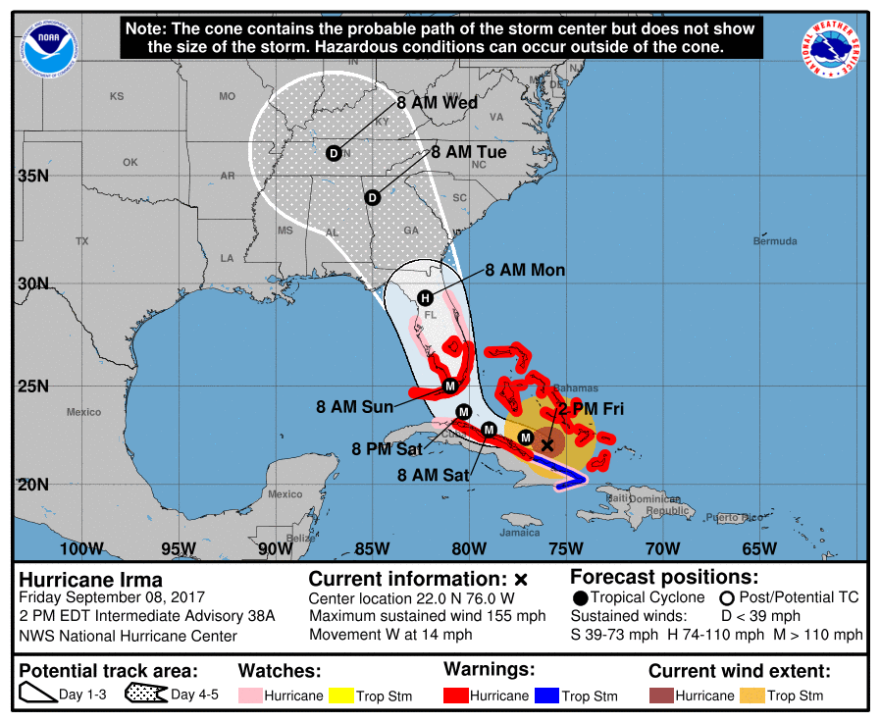Early next week, Irma will make her presence felt in the Carolinas. And it is safe to say her stay will not be a pleasant one. But the severity of the storms impact on the region remains unclear. Still emergency preparations in both states continue.
The hurricane projection maps on social media and cable news channels seem to give North Carolinians reason could breathe a bit easier. Friday, Governor Roy Cooper warned us not to let our guard down just yet.
“Things are looking better for much of North Carolina,” he said. “But we are not yet in the clear.”
Hurricane models now show Irma will likely swing left, hitting just the western section of North Carolina. But there are two things to know about these models warns state meteorologist Katie Webster.
“It is important to remember that the forecast cone is not an impact cone,” Webster said. “But instead a prediction of where the center of the storm may go. Impacts can still be felt far from the center.”
The second thing is the fact Irma is roughly the size of Texas.
Webster said much of North Carolina could, indeed, be affected by Irma.
“The impacts will include heavy rain, gusty winds, isolated tornadoes, mountain landslides, inland and coastal flooding,” she said.
And, of course, power outages caused by the rain, winds and downed trees.
And that’s why Governor Roy Cooper says he’s keeping the state of emergency in effect until the threat has passed.
On Sunday, North Carolina officials will open two staging areas. One in Greensboro, the other in Asheville, to serve as a gathering point for supplies and first responders. A representative from the Federal Emergency Management Agency will also arrive on Sunday just in case.
In addition to this, all North Carolina Department of Transportation construction will be stopped at 7 p.m. Friday. A move to free up the roads, Cooper said, for current evacuees from other states heading north, or for North Carolinian evacuees if it comes to that.
In South Carolina, things are also looking a bit less dire. Governor Henry McMaster warns there could still be flash flooding, high winds and power outages across the state. But he did change the evacuation order that was in place for health care facilities.
“Based on new information,” he said. “I have rescinded the portion of that executive order issued yesterday requiring the mandatory evacuation of health care facilities for some of the counties, not all, but some.”
Health care facilities in three of the southernmost coastal counties, Jasper, Beaufort and Colleton still need to evacuate patients. McMaster is waiting till he learns more information about the storm’s track Friday evening to decide whether to start evacuating residents Saturday.
But those routes are already seeing a good bit of traffic. The head of South Carolina’s transportation department Christy Hall says over the past few days there have been an extra 92,000 cars on the highways, likely from people evacuating Florida and Georgia.
“There are pockets of congestion across the state. I-95, sections of I-26 are congested as well as US 321,” she said. “Traffic is heavy, however, it is moving.”
Hall said extra workers are stationed along those routes to keep traffic moving. There are also more than 2,000 National Guard troops on standby to help if the governor decides to evacuate residents.
RESOURCES
As Hurricane Irma moves north with possible effects on the Carolinas, WFAE has compiled this information to help you prepare. For the most up-to-date information for your specific location install these apps from FEMA and ReadyNC on your mobile phones.
Thes Live Display is monitoring content coming from first responders, government agencies, local news outlets, elected officials and more in real-time. It includes social posts and information from Facebook, Twitter, Instagram and Reddit. We hope it's helpful. You can access it here.
FEMA emergency supplies checklist
Preparing you pets for emergencies
National
Twitter: @NWSNHC
National Aeronautics and Space Administration Hurricane Resource Page
Twitter: @NASAHurricane
Federal Emergency Management Agency
Twitter: @FEMA
Red Cross shelter map
North Carolina
Twitter: @NCEmergency
Pet-friendly shelters in North Carolina
Price gouging complaint form or call 877-5-NO-SCAM
Charlotte-Mecklenburg Emergency Management
Twitter: @CharMeckEM
South Carolina
State Emergency Management Division
Twitter: @SCEMD
Pet-friendly shelters in South Carolina
South Carolina Department of Transportation
Twitter: @ChasCountyGov

Click here for a print version of the North Carolina evacuation map.

Click here for a print version of the South Carolina Evacuation map.







